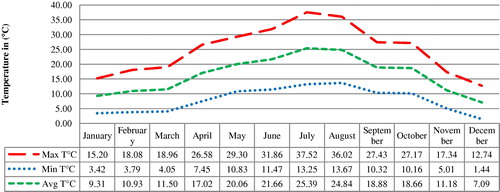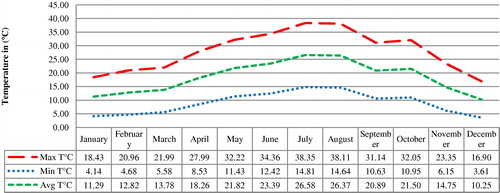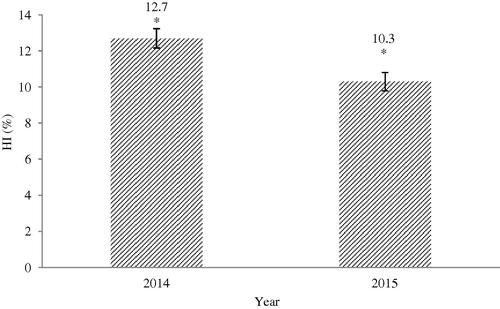Abstract
The objective of this study is to clarify, for the first time in Morocco, the impact of culture on seed yield, growth parameters, yield and antioxidant activity of seed essential oils obtained from wild and cultivated fennel. The cultivation test was installed according to the principles of organic agriculture in a parcel at the oasis of Oukhite South East of Morocco under a completely randomized design with three replications. The agro-morphological characteristics were evaluated during two successive years (2014 and 2015). The results showed that fennel produces more of seed and total dry matter under culture conditions and both are more important in second year. The best performance of seed yield and total dry matter are 20.53 qx/ha and 199.79 qx/ha respectively. Domestication has not improved the yield and the antioxidant activities of fennel seed essential oils. In fact, wild fennel presented an essential oil yield significantly high (3.67%) compared to cultivated fennel (2.13%). For both applied tests DPPH and reducing power, essential oil obtained from wild plant presented the most important antioxidant power (IC50:10.62 ± 0.33 and 29.49 ± 0.52 mg/mL) compared to that extracted from cultivated plant (IC50:13.08 ± 0.34 and 32.30 ± 0.02 mg/mL). However, fennel cultivation is promising. It will permit to achieve interesting seed yields and may be good alternative to safeguard this species as well as to be used as an antioxidant natural source.
1 Introduction
Foeniculum vulgare Mill. commonly known as Fennel is one of the most important medicinal and aromatic plants in the Mediterranean, in Europe and in Egypt (CitationKandil, 2002). It is a rustic perennial plant that can stand droughts and it is generally considered native to the Mediterranean shore (CitationRather et al., 2012). However, it has become widely naturalized in many regions of the world, and it is often found on roadsides, in pastures and other cleared areas. The fennel seeds contain:protein (9.5%), lipids (10%), carbohydrates (42.3%), fiber (18.5%), minerals (calcium, potassium, sodium, iron, phosphorus) and vitamins such as vitamin C, vitamin E, vitamin B6, thiamine, riboflavin and niacin (Badgujar et al., Citation2014; Rather et al., Citation2012"). The stem, fruit, leaf, seed and the whole plant are widely used in many culinary traditions around the world (Özbek et al., Citation2003; Rasul et al., Citation2012"). It is also used as a spice to add flavor to bread, fish, liquors, ice cream, salad and cheese (CitationRather et al., 2012). Due to characteristic smell of the anise seeds (CitationDíaz-Maroto et al., 2006). The smell is caused by terpene compounds isolated from its essential oil (CitationAbdallah et al., 1978). Fennel pollen is also a popular spice (CitationKimberly and Jazmine, 2013) but, it is extremely expensive (CitationMalhotra, 2012). In Addition fennel is used in traditional medicine for the treatment of several diseases (CitationBadgujar et al., 2014). The preparation methods and uses of fennel are well documented in the ethnobotanical literature (CitationGuarrera and Savo, 2013). In fact, some therapeutic and pharmacological proprieties have been attributed to the extract and essential oils of different parts of the fennel such as anti-inflammatory (CitationChoi and Hwang, 2004), hepatoprotective (CitationÖzbek et al., 2003), anti-hirsutism (CitationJavidnia et al., 2003), antitumor (CitationPradhan et al., 2008), estrogenic (CitationMalini et al., 1984), antistress (CitationKoppula and Kumar, 2013), antioxidant (CitationSingh et al., 2006), antidiabetic (CitationEl-Soud et al., 2011), Oculohypotensive (CitationAgarwal et al., 2008), anticarcinogenic (CitationMohamad et al., 2011), antiaging (CitationRasul et al., 2012), antithrombotic (CitationTognolini et al., 2007), apoptotic (CitationBogucka-Kocka et al., 2008), antiulcérogenic (CitationBirdane et al., 2007), antibacterial (Ghouati et al., Citation2014; Lo Cantore et al., Citation2004"), acaricide (CitationLee, 2004), antifungal activity (CitationAbed, 2007), antispasmodic (CitationReynolds, 1982). Therefore, it is clear that the whole fennel plant has received renewed interest by medical, culinary and cosmetic industries. In the last few years, demand has increased considerably, especially for organic fennel in Europe, USA, Canada and Japan (CitationMalhotra, 2012). This increase on demand can only be satisfied through cultivation, though 75–90% of medicinal plants marketed in the world always come from wild harvest (CitationRapporto ISMEA - Osservatorio delle piante officinales, giugno, 2013). Moreover, the drug and pharmaceutical industry, preferred cultivated plant material of aromatic and medicinal plants because it is easier to control production in terms of quality and quantity. This also provides opportunities for its diversification. The use of cultivated plants essentially eliminates problems such as adulteration or misidentification of material (CitationLubbe and Verpoorte, 2011).
The fennel by-products in oasis environment are qualified to be used as fodder for livestock specifically for sheep breed named “D’Man” known for its prolific and lactating qualities as the fennel promotes the secretion of milk due to its properties galactogogues (CitationAgarwal et al., 2008). In addition, biomass fennel can be used to extract natural dyes that can be applied in the textiles industry as an alternative to synthetic dyes (CitationHaddar et al., 2014). Moreover, CitationRao et al. (2010) reported that fennel residues, after the extraction of essential oil, can be used to sequester Cd cadmium (II) ions from waste water.
In fact, fennel domestication, which grows in a wild sate in oasis, would ensure a regular and sustainable supply of this plant and in a long-term would guarantee ex situ conservation of this species which is threatened with extinction, under the combined effect of population pressure and climate aridity. Furthermore, the effect of cultivation on contents of fennel seeds essential oils and their antioxidant activities has not been widely studied, especially in the oasis environment where this species is wide spread.
The present work intends to examine the impact of domestication on seed yield, growth parameters as well as yield and antioxidant activities of essential oils obtained from seeds of wild fennel and fennel cultivated based upon principals of organic agriculture principles in the Moroccan oasis.
2 Material and method
2.1 Plant material
The seeds of wild fennel (Foeniculum vulgare Mill) were collected at the beginning of October 2014 from 40 tufts (each tuft contains 6–25 individual) with an interspace in the range 5–30 m, belong to the natural population located in Gourama, Southeastern Morocco (N 32 °18′25.719″ W 3 °58′59.281″), at an altitude of 1277 m where the soil is sandy clay. The total rainfall recorded in the collection site during the period framing, from September 2013 until October 2014, of the crop cycle is 139 mm. the collected seeds are stored in a refrigerator at 4 °C until use.
2.2 Experimental assay
The cultivation of wild fennel was carried on January 21st, 2014 in a plot set fallow for the previous 4 years, located in the oasis of Oukhite Southeastern Morocco (N 31 ° 27′21″- W 4 ° 36′19″) at an altitude of 909 m above the sea level. The plot of our experiment is located in an isolated farm, which makes it optimal for organic production. The type of the soil was sandy loam (according to USDA soil textural classification) (80% sand, 5% clay and 15% loam) containing 0.63% of organic matter, 0.06% of total nitrogen 0.82 meq/100 g of potassium, 75 mg/kg of available phosphorus and having a pH of 8.58. Fennel was cultivated according to the principles of organic farming. Thus, no chemical inputs were used. The plot was organically fertilized (2.2 tonne/ha) (). Each elementary plot consisted of 6 lines of 5 m in length with a space of 25 cm between the lines. Fennel seeds were sown manually in line with sowing dose calculated to be 12 kg/ha and irrigated by a drip system every two days using an irrigation dose of approximately 3750 m3/ha/cycle. After the emergence stage which occurred on 08/02/2014, the thinning operation was carried out after the plants reached 8 cm in height in order to set a distance of 30 cm between plants.
Table 1 Characterization of organic fertilizer used in the study.
2.3 Measurements and analyses
2.3.1 Seed yield and growth parameters
The fennel seeds reached a stage of maturity on 20 October and 15 October 2015 for the first and second year respectively.
The fennel seeds were harvested at their full ripeness with a sickle in the early morning, to avoid that the seeds escape. Collected samples were dried in a shaded and a well-ventilated area for ten days. Then threshing was done carefully to avoid breaking theme. Before determination the seed yield expressed in quintals/ha, seeds are subjected to winnowing in order to remove any impurities.
Total dry matter was determined by collecting two random samples from each elementary plot. These samples were weighed after they were drought in an oven at 80 °C for about 48 h.
The harvest index (HI) was calculated using the following formula:
The plant height was measured from the surface of the soil to the highest umbel and was based on 10 plants chosen at random on each elementary plot.
The weight of a thousand seeds was obtained on the basis of the average weight of 3 samples from each repetition consisting of 100 seeds and multiplied by 10 to give the mass of 1000 seeds.
These agro-morphological characteristics were evaluated during two successive years (2014 and 2015).
2.3.2 Extraction methods of essential oils
The extraction of the essential oils was carried out by hydro-distillation method in a Clevenger apparatus according to the method recommended by the European Pharmacopoeia (CitationEuropean Pharmacopoeia, 2005). Three distillations were carried out for an average duration of three hours for each 100 g of fennel seeds collected from our experimental trial and the wild fennel in 2014. The essential oil yield was calculated as the ratio between the volume of oil obtained and the weight of seeds used. The essential oil recovered was dehydrated by anhydrous sodium sulfate and stored in a small opaque flask at 4 °C in a dark place before analysis.
2.3.3 Antioxidant activities
2.3.3.1 Free radical scavenging activity
The radical scavenging activity of essential oils of the fennel seeds under study was determined using DPPH method previously described by CitationŞahin et al. (2004). The radical scavenging activity of essential oils is inversely proportional to the concentration of DPPH radicals which shows peak absorbance at 517 nm. The different concentrations of essential oils extracted from fennel seeds and positive control (quercetin and Buthyl-hydroxy-toluene (BHT)) were prepared in methanol. Doses of 50 µL of each concentration were mixed with 2 mL of DPPH solution prepared in methanol at 60 µM. The reaction mixture was vigorously stirred and incubated in the dark for 20 min at room temperature. The absorbance of the resulting solutions was measured at 517 nm. The percentage of free radicals inhibition in percentages is computed using the following formula:
The graph representing the variation in the percentage of DPPH reduction depending on the concentration of the essential oil is used to determine the concentration corresponding to 50% inhibition (IC50) which is the antioxidant activity of the essential oil. This value is compared to those found for the reference compounds (BHT and quercetin). The test was performed three times to calculate the average of IC50.
2.3.3.2 Reducing power assay
The reducing power of a sample is associated with its antioxidant power. The reducing activity of tested samples is determined using the method of CitationOyaizu (1986) based on the reduction of Iron (III) in the complex K3Fe(CN)6 to an Iron (II). The absorbance of reaction medium was determined at 700 nm. The color intensity of the reaction mixture was proportional to samples reducing power. Different concentrations of essential oils and positive control (quercetin; Buthyl-hydroxy-toluene (BHT)) were prepared in methanol. 1 mL of each concentration was mixed with 2.5 mL of phosphate buffer (0.2 mol/L, pH 6.6) and 2.5 mL of 1% solution of potassium ferricyanide [K3Fe(CN)6]. The mixture was incubated at 50 C for 20 min. After incubation, 2.5 mL of 10% trichloroacetic acid solution was added to stop the reaction. The solution was centrifuged for 10 min at 3000 rpm/min. The supernatant (2.5 mL) was mixed with 2.5 mL of distilled water and 0.5 mL of ferric chloride (1%). The Absorbance was measured at 700 nm against a blank prepared in the same manner, replacing the essential oil with distilled water which was used to calibrate the spectrophotometer. The IC50 values were calculated from the plotted graph of the reducing activity against the concentrations of the samples. The test was performed three times to calculate the average IC50.
2.4 Statistical analysis
Statistical analysis was performed using StatView 5.0 software. The experimental results were reported as mean ± SD (standard deviation) (n = 3). Analysis of variance (ANOVA) and post-hoc Fisher PLSD (p < 0.05) tests were used to compare the experimental groups. Differences at p < 0.05 were considered significant.
3 Results and discussion
3.1 Seed yield and growth parameters
The variations of seed yield and growth parameters according to each years of the experiment for domesticated fennel are illustrated in –.
The statistical analysis revealed high significant differences between years of the study for total dry matter (P < 0.05) of domesticated fennel. This result is similar to that found by (CitationKoudela and Petříková, 2008). The highest total dry matter was recorded in the second year (199.79 ± 2.59 quintals/ha) with an increase exceeding that of the first year by 85.73% (). This could be related to age of the plants that affect the vegetative growth and this result concord with those reported by CitationKingsley-Richards, 2011 who has found that plant age had an effect on both rating and dry weight of herbaceous perennials. In fact, the vegetative growth of fennel was strongly affected by cultivars, levels and types of fertilization (CitationOsman, 2009). The total average dry matter for both years is 153.68 quintals/ha. This biomass represents an abundant loss in fennel culture (CitationSenatore et al., 2013). Therefore, valuing these by-products remains necessary. The average height of the fennel plants, varied from 1.47 to 1.82 m, and did not show a significant difference between years (P > 0.05) (). These results are similar to those reported by CitationEhsanipour et al. (2012) but higher than those found by CitationZahid et al. (2009) who found a height of fennel plants in the range 69.2–119 cm. These differences can be attributed to genetic factors, geographical origin and agricultural practices in particular mineral fertilization. In fact, CitationAbd El-Salam (1999) reported that the increase of phosphorus fertilization on fennel result in an increase in plant height.
Fig. 1 Annual evolution of total dry matter of cultivated fennel. Data were expressed as mean (n = 3) ± SD, *P < 0.01compared to each other.
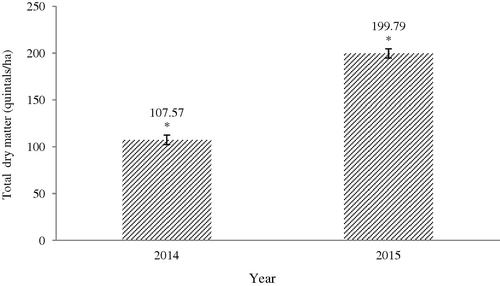
Fig. 2 Annual evolution of height of cultivated fennel. Data were expressed as mean (n = 3) ± SD, *P < 0.01compared to each other.
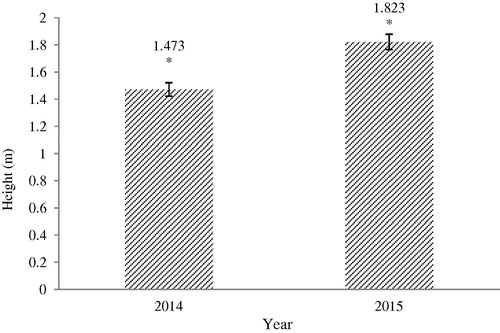
Similarly, the weight of thousand seeds (TSW) showed no significant difference between the years (P > 0.05). However, the TSW of the first year (3.67 g) is slightly higher than that of the second year (2.67 g) (). These values are lower compared to the results reported by CitationZahid et al., 2009. This may be due to several factors including those related to cultural conditions, genotype and geographical origin and harvested date (CitationTelci et al., 2009).
Fig. 3 Annual evolution of weight thousand seeds (WTS) of cultivated fennel. Data were expressed as mean (n = 3) ± SD, *P < 0.01compared to each other.
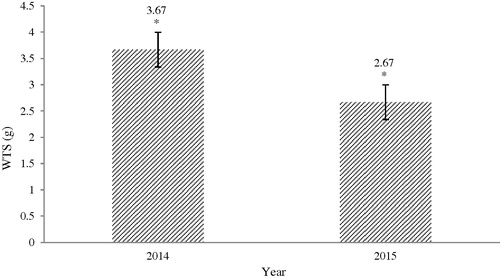
Regarding seed yield, the analysis of variance detected a significant difference between years (P < 0.05). This trend was also observed by CitationBahmani et al. (2015) who evaluated agro-morphological characteristics during two successive years of 50 fennel species from several Iranian regions.
In fact, the highest seed yield was observed in the second year (20.53 quintals/ha) with an increase of 49.71% compared to the first year (). These recorded average yields are much higher than those reported by CitationEhsanipour et al. (2012) on Iranian fennel (4.98–13.30 quintals/ha). CitationMalhotra (2012) reported that seed yield of 20–25 quintals/ha can be achieved through scientific crop management. However, the best performances of fennel in terms of seed yield reported by CitationBahmani et al. (2015) are associated with types of soil at average maturity (33.6–61 quintals/ha).
Fig. 4 Annual evolution of seed yield of cultivated fennel. Data were expressed as mean (n = 3) ± SD, *P < 0.01compared to each other.
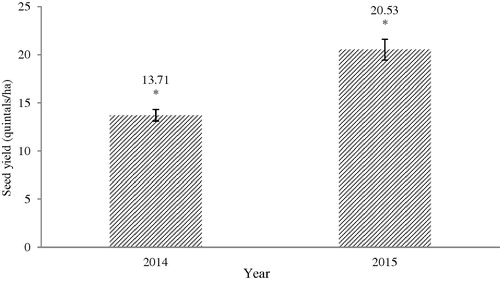
This disparity in results could be due mainly to differences in growing conditions and genetic factors. Based on these results, cultivated fennel may ensure an important seed yield with the organic designation benefits. This domestication will preserve also the precious oasis area known to be very fragile in ecological terms. Besides, organic spices are sold at prices 20–50% higher than spices from conventional farms (CitationPeter and Shylaja, 2012) and the demands has grown rapidly during the last decades.
The harvest index (HI), ranged between 9% ane 14% with an average of 12.75% in the first year and 10.28% in the second year (). The harvest index was not significantly influenced by year (P > 0.05).
3.2 Essential oil yield
The essential oil yield represents the first important sign of differences between wild and domesticated fennel. The essential oil obtained is a light yellow liquid with a fennel specific flavor. Average essential oils yields from wild and cultivated fennel were expressed in milliliter per 100 g of seeds (). Significant differences (P > 0.05) were observed in essential oil yield between cultivated and wild fennel.
Fig. 6 Essential oil yield (EOY) of fennel. Data were expressed as mean (n = 3) ± SD, *P < 0.01compared to each other.
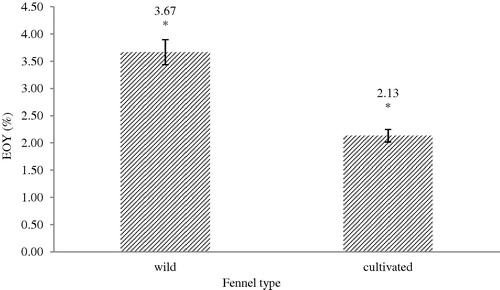
Wild fennel yielded a higher amount of oil (3.67 ± 0.13%) than cultivated fennel, which yielded (2.13 ± 0.07%). This difference was due to factors such as low temperatures and altitudes (site of Wild fennel:1277 m; Cultivation site:909 m), which provide optimal conditions for the accumulation of essential oils (CitationPirbalouti et al., 2013). The area where the wild fennel was collected met those conditions ( and ).
The essential oil yields reported in this study are similar to those reported by CitationMalhotra (2012) for fennel seeds coming from Europe, but higher than those found by (CitationEhsanipour et al. (2012).
This variation in essential oil content of fennel seeds depends on environmental conditions, geographic origin and genetic factors (CitationBahmani et al., 2015), distillation time (CitationMoser et al., 2014), phenological stage (CitationTelci et al., 2009) and agricultural practices (CitationMona et al., 2008). Our results therefore showed that domestication has not improved essential oil production although many researchers have shown that certain agricultural practices could improve fennel essential oil content (Ehsanipour et al., Citation2012; Osman, Citation2009").
This pattern was also reported by CitationDincer et al. (2012) who worked on domestication of sage (Salvia fruticosa). However, the results of the work by CitationKasrati et al. (2013) on (Mentha suaveolens subsp timija (Briq).); CitationEconomakis et al. (1999) on oregano (Origanum dictamnus) and CitationEl Bouzidi et al. (2013) on thyme (Thymus sp) reported that domestication doesn’t have a significant effect on essential oil content. On the other hand, domestication of absinthe populations (Artemisia absinthium) (CitationJulio et al., 2015) and thyme (Thymus daenensis Celak) (CitationPirbalouti et al., 2013) has given higher essential oil yield. These contradictory findings regarding essential oil yield could be due to differences in growing conditions especially soils, climate, irrigation and cultivation techniques.
3.3 Essential oils antioxidant activities
Essential oils antioxidant activity of both cultivated and wild fennel seed was evaluated in vitro by DPPH free radical scavenging activity and reducing power on potassium ferricyanide and expressed in IC50. These values are presented in .
Table 2 Essential oils antioxidant activities of wild and cultivated fennel seed.
The results show that the two studied essential oils presented highly significant antioxidant capacities using the two assays (P < 0.0001). However, cultivation did not improve this activity. In fact, for two the tests used (DPPH and reducing power), essential oil obtained from the wild plants presented the higher antioxidant power (IC50:10.62 ± 0.33 and 29.49 ± 0.52 mg/mL) compared to that extracted from the cultivated plants (IC50:13.08 ± 0.34 and 32.30 ± 0.02 mg/mL).This is probably a result of the increase of biotic and abiotic stress in wild fennel, which causes high concentrations of secondary metabolites which possessed the antioxidant activity known as anethole (CitationSenatore et al., 2013).
Based on their study, conducted on chemical composition and antioxidant activity of essential oils of Foeniculum vulgare, CitationEl Ouariachi et al. (2014) mentioned that wild fennel from Morocco can be a potential source of natural antioxidants. Similarly, CitationFaudale et al. (2008) have found that wild fennel from different Mediterranean countries, exhibits radicals scavenging activity greater than edible fennel. The same trend was also reported by CitationGhanem et al. (2012). Regarding the DPPH test, antioxidant capacity of our essential oils remains more effective than that reported by CitationShahat et al. (2011) on Egyptian fennel cultivar (Foeniculum vulgare var vulgare) grown organically (IC50:15.33 mg/mL). However, they are less active than those cited by CitationAnwar et al. (2009) on fennel from Pakistan (IC50:32.32 mg/mL). These differences appear to be caused by to several factors including geographical origin, climatic conditions (CitationFaudale et al., 2008) and distillation time (CitationMoser et al., 2014). In addition, antioxidant powers of BHT and Quercetin used as standard antioxidant remains much higher than the studied essential oils for all used tests.
On the other hand, many researchers reported that there is no significant change in antioxidant activity of essential oils from wild and cultivated plants of other species of genus Salvia fruticosa Miller (CitationDincer et al., 2012) Thymus Maroccanus, Thymus broussonetii and Thymus satureioides (CitationEl Bouzidi et al., 2013). However, domestication has improved the antioxidant activity of other aromatic and medicinal plants such as sage (Salvia aucheri subsp. Blancoana) (CitationKhiyari et al., 2014), laurel (Laurus nobilis L.) (CitationDias et al., 2014) and damiana (Turnera diffusa Willd) (CitationSoriano-Melgar et al., 2012).
Based on data obtained from this study, essential oils of oasis fennel seeds whether wild or cultivated showed antioxidant properties that may protect body cells against damage caused by oxidative stress (CitationScalbert et al., 2005). Moreover, many studies correlate consumption of edible wild plants in Mediterranean to the low cardiovascular disease incidence as well as reduced the risk of cancer disease and Alzheimer’s (La Vecchia, Citation2009; Scarmeas et al., Citation2006").
4 Conclusion
This work addresses, for the first time in Morocco, the domestication of wild fennel. The results show the ability of this species to produce more both in seed and total dry matter under culture conditions based on organic agriculture principles that may contribute to the preservation of the oasis area known to be very fragile in ecological terms. Although cultivation did not improve yield and antioxidant activity of fennel seeds essential oils, but it may be a good alternative to safeguard this species as well as its use as natural antioxidant with other benefits such as organic labels. However, more studies on the effects of certain environmental factors and cultural practices on fennel essential oils yield and chemical composition in oasis context, remains necessary to optimize its domestication and to identify favorable environmental conditions for producing safe bioactive molecules that could be used in several fields.
Conflict of interest
The authors have no conflict of interest.
Notes
Peer review under responsibility of University of Bahrain.
References
- I.Z.Abd El-SalamPhysiological Studies on Foeniculum vulgare Mill. Plants (Ph.D thesis)1999Fac. Agric. Cairo. Univ.Egypt
- N.AbdallahS.El-GengaihiE.SedrakThe effect of fertilizer treatments on yield of seed and volatile oil of fennel (Foeniculum vulgare Mill.)Pharmazie3391978607608
- K.F.AbedAntimicrobial activity of essential oils of some medicinal plants from Saudi ArabiaSaudi J. Biol. Sci.14120075360
- R.E.N.U.AgarwalS.K.GuptaS.S.AgrawalS.U.S.H.M.A.SrivastavaR.O.H.I.T.SaxenaOculohypotensive effects of Foeniculum vulgare in experimental models of glaucomaIndian J. Physiol. Pharmacol.52120087783
- F.AnwarM.AliA.I.HussainM.ShahidAntioxidant and antimicrobial activities of essential oil and extracts of fennel (Foeniculum vulgare Mill.) seeds from PakistanFlavour Fragrance J.2442009170176
- S.B.BadgujarV.V.PatelA.H.BandivdekarFoeniculum vulgare Mill: a review of its botany, phytochemistry, pharmacology, contemporary application, and toxicologyBioMed Res. Int.2014
- K.BahmaniA.I.DarbandiH.A.RamshiniN.MoradiA.AkbariAgro-morphological and phytochemical diversity of various Iranian fennel landracesInd. Crops Prod.772015282294
- F.M.BirdaneM.CemekY.O.BirdaneI.GulcinM.E.BuyukokurogluBeneficial effects of Foeniculum vulgare on ethanol-induced acute gastric mucosal injury in ratsWorld J. Gastroenterol.1342007607
- A.Bogucka-KockaH.D.SmolarzJ.KockiApoptotic activities of ethanol extracts from some Apiaceae on human leukaemia cell linesFitoterapia7972008487497
- E.M.ChoiJ.K.HwangAntiinflammatory, analgesic and antioxidant activities of the fruit of Foeniculum vulgareFitoterapia7562004557565
- M.I.DiasL.BarrosM.DueñasR.C.AlvesM.B.P.OliveiraC.Santos-BuelgaI.C.FerreiraNutritional and antioxidant contributions of Laurus nobilis L. leaves: would be more suitable a wild or a cultivated sample?Food Chem.1562014339346
- M.C.Díaz-MarotoM.S.Pérez-CoelloJ.EstebanJ.SanzComparison of the volatile composition of wild fennel samples (Foeniculum vulgare Mill.) from Central SpainJ. Agric. Food Chem.5418200668146818
- C.DincerA.TopuzH.Sahin-NadeemK.S.OzdemirI.B.CamI.TontulR.S.GokturkS.T.AyA comparative study on phenolic composition, antioxidant activity and essential oil content of wild and cultivated sage (Salvia fruticosa Miller) as influenced by storageInd. Crops Prod.392012170176
- C.EconomakisC.DemetzosT.AnastassakiV.PapazoglouM.GazouliA.LoukisC.A.ThanosC.HarvalaVolatile constituents of bracts and leaves of wild and cultivated Origanum dictamnusPlanta Med.6521999189191
- A.EhsanipourJ.RazmjooH.ZeinaliEffect of nitrogen rates on yield and quality of fennel (Foeniculum vulgare Mill.) accessionsInd. Crops Prod.3512012121125
- L.El BouzidiC.A.JamaliK.BekkoucheL.HassaniH.WohlmuthD.LeachA.AbbadChemical composition, antioxidant and antimicrobial activities of essential oils obtained from wild and cultivated Moroccan Thymus speciesInd. Crops Prod.432013450456
- E.M.El OuariachiN.LahhitA.BouyanzerB.HammoutiJ.PaoliniL.MajidiJ.-M.DesjobertJ.CostaChemical composition and antioxidant activity of essential oils and solvent extracts of Foeniculum vulgare Mill. from MoroccoJ. Chem. Pharm. Res.642014743748
- N.El-SoudN.El-LaithyG.El-SaeedM.WahbyM.KhalilF.MorsyN.ShaffieAntidiabetic activities of Foeniculum vulgare mill. Essential oil in streptozotocin-induced diabetic rats. MacedonianJ. Med. Sci.422011139146
- European PharmacopoeiaCouncil of Europe5th ed.2005EDQMStrasbourg
- M.FaudaleF.ViladomatJ.BastidaF.PoliC.CodinaAntioxidant activity and phenolic composition of wild, edible, and medicinal fennel from different Mediterranean countriesJ. Agric. Food Chem.566200819121920
- M.T.GhanemH.M.RadwanE.S.M.MahdyY.M.ElkholyH.D.HassaneinA.A.ShahatPhenolic compounds from Foeniculum vulgare (Subsp. Piperitum)(Apiaceae) herb and evaluation of hepatoprotective antioxidant activityPharmacogn. Res.422012104
- Y.GhouatiT.BelaicheM.OuhssineA.AmechrouqA.TahiriS.ChakirAntimicrobial property of the essential oil from the Moroccan fennel fruitsGlobal J. Pure Appl. Chem. Res.1120142533
- P.M.GuarreraV.SavoPerceived health properties of wild and cultivated food plants in local and popular traditions of Italy: A reviewJ. Ethnopharmacol.14632013659680
- W.HaddarI.ElksibiN.MeksiM.F.MhenniValorization of the leaves of fennel (Foeniculum vulgare) as natural dyes fixed on modified cotton: a dyeing process optimization based on a response surface methodologyInd. Crops Prod.522014588596
- K.JavidniaL.DastgheibS.M.SamaniA.NasiriAntihirsutism activity of fennel (fruits of Foeniculum vulgare) extract–a double-blind placebo controlled studyPhytomedicine1062003455458
- L.F.JulioJ.BurilloC.GiménezR.CabreraC.E.DíazJ.SanzA.González-ColomaChemical and biocidal characterization of two cultivated Artemisia absinthium populations with different domestication levelsInd. Crops Prod.762015787792
- Kandil, M.A.M.H., 2002. The effect of fertilizers for conventional and organic farming on yield and oil quality of fennel (Foeniculum vulgare Mill.) in Egypt. PhD Thesis, Technischen Universitat Carolo – Wilheminazu Braunschweig – Germany.
- A.KasratiC.A.JamaliK.BekkoucheH.LahcenM.MarkoukH.WohlmuthD.LeachA.AbbadEssential oil composition and antimicrobial activity of wild and cultivated mint timija (Mentha suaveolens subsp. timija (Briq.) Harley), an endemic and threatened medicinal species in MoroccoNat. Prod. Res.2712201311191122
- M.E.A.KhiyariA.KasratiC.A.JamaliS.ZeroualM.MarkoukK.BekkoucheA.AbbadChemical composition, antioxidant and insecticidal properties of essential oils from wild and cultivated Salvia aucheri subsp. blancoana (Webb. & Helder)), an endemic, threatened medicinal plant in MoroccoInd. Crops Prod.572014106109
- F.KimberlyC.JazmineSummer Fennel Pollen Recipes2013Pollen Ranch and the Hungry GoddessItaly
- Kingsley-Richards, S., 2011. Influence of Plant Age, Soil Moisture, and Temperature Cylcing Date on Containter-Grown Herbaceous Perennials.
- S.KoppulaH.KumarFoeniculum vulgare Mill (Umbelliferae) attenuates stress and improves memory in wister ratsTrop. J. Pharm. Res.1242013553558
- M.KoudelaK.PetříkováNutritional compositions and yield of sweet fennel cultivars-Foeniculum vulgare Mill. ssp. vulgare var. azoricum (Mill.)Thell. Hort. Sci.351200816
- C.La VecchiaAssociation between Mediterranean dietary patterns and cancer riskNutr. Rev.67Suppl. 12009S126S129
- H.S.LeeAcaricidal activity of constituents identified in Foeniculum vulgare fruit oil against Dermatophagoides spp. (Acari: Pyroglyphidae)J. Agric. Food Chem.5210200428872889
- P.Lo CantoreN.S.IacobellisA.De MarcoF.CapassoF.SenatoreAntibacterial activity of Coriandrum sativum L. and Foeniculum vulgare Miller var. vulgare (Miller) essential oilsJ. Agric. Food Chem.5226200478627866
- A.LubbeR.VerpoorteCultivation of medicinal and aromatic plants for specialty industrial materialsInd. Crops Prod.342011785801
- S.K.MalhotraFennel and Fennel Seed2012Indian Council of Agricultural ResearchIndia
- T.MaliniG.VanithakumariN.MegalaS.AnusyaK.DeviV.ElangoEffect of Foeniculum vulgare Mill. seed extract on the genital organs of male and female ratsIndian J. Physiol. Pharmacol.29119842126
- R.H.MohamadA.M.El-BastawesyM.G.Abdel-MonemetAntioxidant and anticarcinogenic effects of methanolic extract and volatile oil of fennel seeds (Foeniculum vulgare)J. Med. Food14920119861001
- Y.MonaA.M.KandilM.F.Swaefy HendEffect of three different compost levels on fennel and salvia growth character and their essential oilsRes. J. Agric. Biol. Sci.4120083439
- B.R.MoserV.D.ZheljazkovE.L.BakotaR.L.EvangelistaA.GawdeC.L.CantrellJ.K.Winkler-MoserA.N.HristovT.AstatkieE.JeliazkovaMethod for obtaining three products with different properties from fennel (Foeniculum vulgare) seedInd. Crops Prod.602014335342
- Y.A.H.OsmanComparative study of some agricultural treatments effects on plant growth, yield and chemical constituents of some fennel varieties under Sinai conditionsRes. J. Agric. & Biol. Sci.542009541554
- M.OyaizuStudies on products of browning reaction–antioxidative activities of products of browning reaction prepared from glucosamineJpn. J. Nutr.441986307315
- H.ÖzbekS.UğraşH.DülgerI.BayramI.TuncerG.ÖztürkA.ÖztürkHepatoprotective effect of Foeniculum vulgare essential oilFitoterapia7432003317319
- K.V.PeterM.R.ShylajaIntroduction to herbs and spices: Definition, trade and applicationsHandbook of Herbs and Spices2012Woodhead PublishingCambridge, UK5570
- A.G.PirbaloutiM.HashemiF.T.GhahfarokhiEssential oil and chemical compositions of wild and cultivated Thymus daenensis Celak and Thymus vulgaris LInd. Crops Prod.4820134348
- M.PradhanS.SribhuwaneswariD.KarthikeyanS.MinzP.SureA.N.ChanduT.SivakumarIn-vitro cytoprotection activity of Foeniculum vulgare and Helicteres isora in cultured human blood lymphocytes and antitumour activity against B16F10 melanoma cell lineRes. J. Pharm. Technol.142008450452
- R.A.K.RaoM.A.KhanF.RehmanUtilization of Fennel biomass (Foeniculum vulgari) a medicinal herb for the biosorption of Cd (II) from aqueous phaseChem. Eng. J.15612010106113
- Rapporto ISMEA – Osservatorio delle piante officinali, giugno 2013.
- A.RasulN.AkhtarB.A.KhanT.MahmoodS.U.ZamanH.M.KhanFormulation development of a cream containing fennel extract: in vivo evaluation for anti-aging effectsPharmazie67120125458
- M.A.RatherB.A.DarS.N.SofiB.A.BhatM.A.QurishiFoeniculum vulgare: A comprehensive review of its traditional use, phytochemistry, pharmacology, and safetyArabian J. Chem.2012 in press
- J.E.F.ReynoldsEssential Oils and Aromatic Carminatives, Martindale-the Extra, Pharmacopeia28th ed.1982Royal Pharmaceutical SocietyLondon670676
- F.ŞahinM.GüllüceD.DafereraA.SökmenM.SökmenM.PolissiouG.AgarH.ÖzerBiological activities of the essential oils and methanol extract of Origanum vulgare ssp. vulgare in the Eastern Anatolia region of TurkeyFood Control1572004549557
- A.ScalbertC.ManachC.MorandC.RémésyL.JiménezDietary polyphenols and the prevention of diseasesCrit. Rev. Food Sci. Nutr.4542005287306
- N.ScarmeasY.SternM.X.TangR.MayeuxJ.A.LuchsingerMediterranean diet and risk for Alzheimer’s diseaseAnn. Neurol.5962006912921
- F.SenatoreF.OlivieroE.ScandoleraO.Taglialatela-ScafatiG.RoscignoM.ZaccardelliE.De FalcoChemical composition, antimicrobial and antioxidant activities of anethole-rich oil from leaves of selected varieties of fennel [Foeniculum vulgare Mill. ssp. vulgare var. azoricum (Mill.) Thell]Fitoterapia902013214219
- A.A.ShahatA.Y.IbrahimS.F.HendawyE.A.OmerF.M.HammoudaF.H.Abdel-RahmanM.A.SalehChemical composition, antimicrobial and antioxidant activities of essential oils from organically cultivated fennel cultivarsMolecules162201113661377
- G.SinghS.MauryaM.P.De LampasonaC.CatalanChemical constituents, antifungal and antioxidative potential of Foeniculum vulgare volatile oil and its acetone extractFood Control1792006745752
- L.D.A.A.Soriano-MelgarL.Alcaraz-MeléndezL.C.Méndez-RodríguezM.E.PuenteF.Rivera-CabreraT.Zenteno-SavínAntioxidant and trace element content of damiana (Turnera diffusa Willd) under wild and cultivated conditions in semi-arid zonesInd. Crops Prod.3712012321327
- I.TelciI.DemirtasA.SahinVariation in plant properties and essential oil composition of sweet fennel (Foeniculum vulgare Mill.) fruits during stages of maturityInd. Crops Prod.3012009126130
- M.TognoliniV.BallabeniS.BertoniR.BruniM.ImpicciatoreE.BarocelliProtective effect of Foeniculum vulgare essential oil and anethole in an experimental model of thrombosisPharmacol. Res.5632007254260
- N.Y.ZahidN.A.AbbasiI.A.HafizZ.AhmadGenetic diversity of indigenous fennel,(Foeniculum vulgare Mill) germplasm in Pakistan assessed by RAPD markersPak. J. Bot.414200917591767

